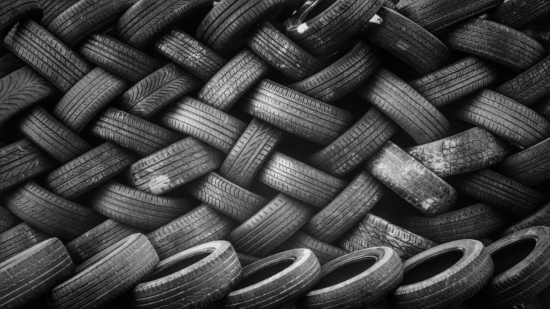China’s tyre recycling industry lags behind
 In recent years, ZC Rubber, Linglong, Doublestar and other tyre manufacturers have started to get involved in the waste tyre recycling business (Photo: Imthaz Ahamed; Unsplash)
In recent years, ZC Rubber, Linglong, Doublestar and other tyre manufacturers have started to get involved in the waste tyre recycling business (Photo: Imthaz Ahamed; Unsplash)
In recent years, authorities in many regions of China have put waste tyre recycling on their agenda. Recycling waste tyres is a reusable resource that aligns with China’s current green and sustainable development policy and can bring profits to tyre companies. Tyrepress China notes that ZC Rubber, Linglong, Doublestar and other tyre manufacturers have begun to lay out their plans in this industry. For example, in December 2022, Linglong Anhui Manufacturing Base announced that it was preparing to launch a project to recycle 30,000 tons of waste tyres annually and its feasibility study provides numerous insights into the development of the wider Chinese tyre recycling business.
Overall capacity utilisation is low
The recycling modes of waste tyres include tyre retreading, making reclaimed rubber, making rubber powder and pyrolysis of waste tyres. Among them, reclaimed rubber can be used again for tyre manufacturing. Retreaded tyres can be reused, but the usage scenarios are limited.
In 2021, more than 100,000 people in China were engaged in jobs related to the tyre recycling industry. Between them, they recycled about 210 million waste tyres. Tyre recycling companies used waste tyres as one of the raw materials to produce four different products: Reclaimed rubber had the highest output in 2021, reaching 3.2 million tons. Production of retreaded tyres was the lowest at 260,000 tonnes, equivalent to 5.2 million tyres in size 9.00-20. Pyrolysis and crumb rubber production provided 1.25 million tons and 1.3 million tons of products respectively.
The overall capacity utilisation rate of China’s waste tyre recycling industry is low. In 2021, factors such as rising raw material costs, the epidemic and environmental protection regulations harmed the entire industry. During the year, the capacity utilisation rate for tyre retreading was 65.1 per cent. The capacity utilisation rate of rubber powder (crumb rubber) manufacturing reaches 75.5 per cent, the highest among waste tyre recycling modes. Meanwhile, the capacity utilisation rate of pyrolysis production is only 24.8 per cent.
Retreaded tyre production decreased
China’s tyre retreading industry has developed in recent years, and most large-scale tyre retreading companies have established relatively stable cooperative relations with transportation companies. However, compared with the tyre manufacturing industry, which frequently invests hundreds of millions of yuan in expanding production, the retreading tyre industry still has a long way to go.
According to the data produced by some enterprises, the capacity utilisation rate of tyre retreading is still at a low level, not even reaching the 65.1 per cent mentioned above. According to data from one of the Chinese associations, the designed production capacity of 32 retreaded tyre companies in 2020 is 2.0507 million retreads, but the actual output is only 686,000, and the capacity utilisation rate is only about 33.5 per cent. Fujian, Jiangsu, Guangdong, and Shandong are the provinces with the largest designed production capacity of retreaded tyres, with capacities of 671,000, 510,000, 364,500 and 167,000, respectively. The combined production capacity of the four provinces is 1.7125 million, accounting for 83.5 per cent of the total production capacity.
Small businesses are still the leading force in the tyre-retreading industry if divided by size. Among the 32 tyre retreading companies, only 15.6 per cent have an annual retreading volume of 50,000 or more. In contrast, 40.6 per cent of the output was below 10,000 pieces. At the same time, enterprises with an output of 10,000 (inclusive) to 20,000 and 20,000 (inclusive) to 50,000 both accounted for 21.9 per cent. In terms of product types, 16 companies only retread radial tyres, and 15 companies retread radial tyres and bias tyres at the same time. There is only one company whose products are bias tyres.
It is worth noting that from 2018 to 2020, the design capacity and output of China’s retreaded tyre industry may show a decreasing trend year by year. In the past three years, the designed production capacity of retreaded tyres of member companies of the association was 2,748,600 (2018), 2,163,100 (2019), and 2,050,700 (2020). The design capacity of retreaded tyres fell by 25.4 per cent in three years. The public information has not clarified the reasons for the decline in production capacity. China has promoted high-quality development in recent years and eliminated many low-efficiency production capacities, which may be one of the reasons for this situation.
One thing that needs more attention is that while the production capacity is declining, the output of retreaded tyres is also decreasing yearly. In 2018, the output of retreaded tyres of the association’s member units was 1.036 million. In 2019 and 2020, this data is 789,500 and 686,000. Compared with 2018, the output in 2020 fell by 33.8 per cent, even exceeding the proportion of the decline in the design capacity.
Reclaimed rubber benefited from the tyre industry
According to statistics, from 2014 to 2020, the output of reclaimed rubber in China fluctuated somewhat. In 2020, China produced 4.6 million tons of reclaimed rubber, the same as the 2019 figure.
In recent years, the Chinese tyre industry’s demand for reclaimed rubber has promoted its development. In 2020, the market size of China’s reclaimed rubber was 3.98 billion yuan, a year-on-year decrease of 3.86 per cent. From 2014 to 2020, the market size of China’s reclaimed rubber industry fluctuated around 4 billion yuan, with the highest and lowest values being 4.27 billion yuan (2014) and 3.68 billion yuan (2018), respectively.

 Galgo
Galgo

Comments